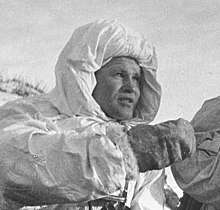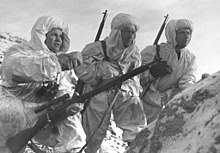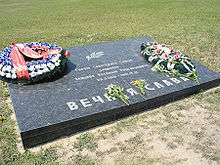Vasily Zaitsev (sniper)
Vasily Grigoryevich Zaytsev (Russian: Васи́лий Григо́рьевич За́йцев, IPA: [vɐˈsʲilʲɪj ɡrʲɪˈɡorʲjɪvʲɪtɕ ˈzajtsɨf]; 23 March 1915 – 15 December 1991) was a Soviet sniper during World War II. Prior to 10 November 1942, he killed 32 Axis soldiers with a standard-issue rifle.[1] Between 10 November 1942 and 17 December 1942, during the Battle of Stalingrad, he killed 225 enemy soldiers, including 11 snipers.[1]
Vasily Grigoryevich Zaytsev | |
|---|---|
 Zaytsev in December 1942 | |
| Native name | Василий Григорьевич Зайцев |
| Nickname(s) | Vasya |
| Born | 23 March 1915 Yeleninskoye, Orenburg Governorate, Russian Empire (now Chelyabinsk Oblast, Russian Federation) |
| Died | 15 December 1991 (aged 76) Kiev, Ukrainian SSR, Soviet Union |
| Buried | Mamayev Kurgan, Volgograd, Russia |
| Allegiance | |
| Years of service | 1937–1945 |
| Rank | Captain |
| Battles/wars | World War II
|
| Awards | Hero of the Soviet Union |
Zaytsev became a celebrated figure during the war and later a Hero of the Soviet Union, and he remains lauded for his skills as a sniper. His life and military career have been the subject of several books and films: his exploits, as detailed in William Craig's 1973 Enemy at the Gates: The Battle for Stalingrad, would serve as the lead figure for the 2001 film Enemy at the Gates, with Jude Law portraying Zaytsev. He is also featured in David L. Robbins's 1991 historical novel War of the Rats.
Early life
Zaytsev was born in Yeleninskoye, Orenburg Governorate in a peasant family of Russian ethnicity[2] and grew up in the Ural Mountains, where he learned marksmanship by hunting deer and wolves with his grandfather and older brother. He brought home his first trophy at the age of 12: a wolf that he shot with a single bullet from his first personal rifle, a large single-shot Berdan, which at the time he was barely able to carry on his back.
He graduated from seven classes of junior high school. In 1930 he graduated from a construction college in the city of Magnitogorsk, where he received the speciality of a fitter. He graduated from accounting courses.
From 1937 he served in the Pacific Fleet, where he was enlisted as clerk of the artillery department. After studying at the Military School, he was appointed head of the finance department of the Pacific Fleet, in Transfiguration Bay. During his service, World War II broke out.
Military career

Zaytsev served in the Soviet Navy as a clerk in Vladivostok. When Nazi Germany invaded the Soviet Union during Operation Barbarossa, Zaytsev, like many of his comrades, volunteered to be transferred to the front line. He was a chief petty officer in the Navy and was assigned the rank of senior warrant officer upon transfer to the army. He was assigned to the 1047th Rifle Regiment of the 284th "Tomsk" Rifle Division, which became part of the 62nd Army at Stalingrad on 17 September 1942.[3]
Zaytsev's accuracy with a rifle led to his becoming a sniper. During Zaytsev's career as a sniper, he concealed himself in various locations – for example, on high ground, under rubble, or in water pipes. After a few kills, he changed his position. Together with his partner Nikolai Kulikov, Zaytsev exercised his hide and sting tactics. One of Zaytsev's common tactics was to cover one large area from three positions, with two men at each point – a sniper and a scout. This tactic, known as the "sixes", is still in use today and was implemented during the war in Chechnya.
Zaytsev fought in the Battle of Stalingrad until January 1943, when a mortar attack injured his eyes. He was attended to by Vladimir Filatov, who is credited with having restored Zaytsev's sight. On 22 February 1943, Zaytsev was awarded the title Hero of the Soviet Union. During this time Zaytsev recruited and trained other marksmen to become snipers during his service in Stalingrad.[4] He returned to the front and finished the war at the Battle of the Seelow Heights in Germany, with the military rank of captain. He became a member of the Communist Party in 1943.
Civilian life
After the war, Zaytsev settled in Kiev, where he studied at a textile university before obtaining employment as an engineer. During the period after war, he fell victim to the post-war "spy frenzy" paranoia, spending 1951-1953 in a pretrial detention center. He rose to become the director of a textile factory in Kiev and remained in that city until he died on 15 December 1991 at the age of 76, eleven days before the dissolution of the Soviet Union. He was initially buried in Kiev despite his final request to be buried at Volgograd.
2006 commemoration

On 31 January 2006, Vasily Zaytsev was reburied with full military honors at the Stalingrad memorial at Mamayev Kurgan in Volgograd.[1] Zaytsev's dying wish was to be buried at the monument to the defenders of Stalingrad. His coffin was carried next to a monument where his famous quote is written: "For us there was no land beyond the Volga".
In popular culture
Film
A feature-length film, Enemy at the Gates (2001), starring Jude Law as Zaytsev, was based on part of William Craig's book Enemy at the Gates: The Battle for Stalingrad (1973), which includes a "snipers' duel" between Zaytsev and a Wehrmacht sniper school director, Major Erwin König. Zaytsev indicates in his own memoirs that a three-day duel did occur and that the sniper he killed was the head of a sniper school near Berlin; however, historian Sir Antony Beevor states that the Russian Ministry of Defence archives contradict this and the duel had been created as Soviet propaganda.[5]
Literature
David L. Robbins's historical novel, War of the Rats (1991) includes a sniper duel in Stalingrad, but between Zaitsev and a German adversary named Colonel Heinz Thorvald, identified in the author's introduction as an actual combatant.[6] Ramón Rosanas wrote a comic about the conflict between Zaytsev and König.[7]
Awards and honors
- Hero of the Soviet Union
- Four Orders of Lenin
- Two Orders of the Red Banner
- Order of the Patriotic War 1st Class
- Medal "For Courage"
- Honorary Citizen of the Hero City of Volgograd
- campaign and jubilee medals
References
- "Biography: Vasily Zaytsev". Heroes of the Soviet Union and Russia (in Russian).
- "Vasily Zaytsev". Warheroes.ru.
- Sharp, Charles C. Sharp (1996). "Red Swarm". Soviet Rifle Divisions Formed From 1942 to 1945, Soviet Order of Battle World War II. X. p. 108.
- Zaitsev, Vassili (March 3, 2017). Notes of a Russian Sniper. 5206 S harper Ave, Chicago, IL: Frontline Books. ISBN 9781848325654.CS1 maint: location (link)
- Beevor, Antony (29 May 2018). "Antony Beevor: the greatest war movie ever – and the ones I can't bear". The Guardian. Retrieved 6 January 2020.
- Robbins, David L. (1991). War of the Rats. Bantam.
- Jiménez, Jesús (19 August 2013). "Ramón Rosanas lleva al cómic al famoso francotirador ruso Vasili Záitsev". Corporación de Radio y Televisión Española (in Spanish). Retrieved 26 January 2019.
Further reading
- Zaytsev, Vasily (2003). Thoughts of a Sniper. Trans. David Givens, Peter Kornakov, Konstantin Kornakov. Ed. Neil Okrent. Los Angeles: 2826 Press Inc. ISBN 978-0-615-12148-2.
- Beevor, Antony (1998). Stalingrad. London: Penguin Books Ltd. ISBN 978-0-14-100131-9.
- Robbins, David L. (2000). War of the Rats. New York: Bantam Books. ISBN 978-0-553-58135-5.
- The Reader's Digest Illustrated History of World War II (1989). London: Reader's Digest Association Limited. ISBN 978-0-89577-333-3
External links
| Wikimedia Commons has media related to Vasily Zaytsev. |
| Wikiquote has quotations related to: Vasily Zaitsev (sniper) |
- (in Russian) Biography of Vasily Zaytsev at WarHeroes.ru